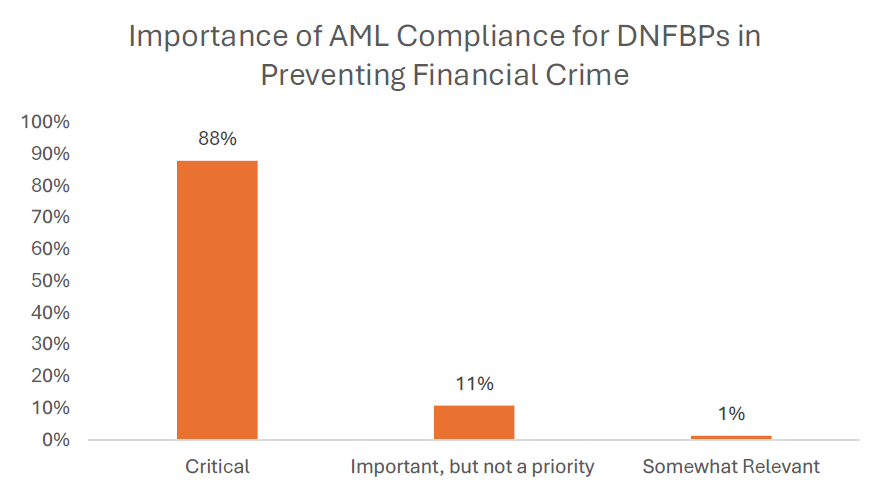 The Asian Bankers Association (ABA) and Fintelekt Advisory Services jointly organised an awareness training programme on “AML/ CFT Compliance for Designated Non-Financial Businesses and Professions (DNFBPs)” on September 11, 2024.
The Asian Bankers Association (ABA) and Fintelekt Advisory Services jointly organised an awareness training programme on “AML/ CFT Compliance for Designated Non-Financial Businesses and Professions (DNFBPs)” on September 11, 2024.
The resource person for the training was Debmalya Maitra. Arpita Bedekar, Chief Operating Officer, Fintelekt Advisory Services facilitated the programme.
The training was attended by more than 550 participants from 28 countries and 174 institutions, with participants representing DNFBPs, banking and financial services community, as well as a few regulators.
At the start of the training, participants were asked about their views on the importance of AML compliance for DNFBPs in preventing financial crime. Out of 295 respondents, 88% believed it was critical, emphasizing that DNFBPs are essential gatekeepers in the fight against money laundering and need strong compliance measures. This response demonstrated the growing importance of the sector, and set the tone for the training.
SUMMARY
(1) Types of DNFBPs
The key DNFBPs include Trust and Company Service Providers, Legal Professionals, Accountants, Real Estate Agents, Developers, Casinos, Dealers in Precious Metals and Stones, and Car Dealers. These sectors are especially prone to misuse, emphasizing the need for swift regulation to reduce associated risks.
(2) Applicable Financial Action Task Force (FATF) Recommendations to DNFBPs
Among FATF’s 40 recommendations, three specifically target DNFBPs, namely:
- Recommendation 22: Requires DNFBPs to perform Customer Due Diligence (CDD) on all clients, ensuring proper understanding of their background and source of funds before entering into a relationship with them.
- Recommendation 23: Enforces rules on foreign business, reporting, confidentiality, and tipping off across all DNFBPs.
- Recommendation 28: Mandates a strict supervisory regime for casinos and other DNFBPs to ensure adherence to AML/CFT measures.
(3) FATF’s Publication on Horizontal Review of Gatekeepers’ Technical Compliance Related to Corruption (July 2024)
This report revealed that over half of 120 reviewed jurisdictions failed to implement the required obligations for the gatekeepers, showing a poor understanding of financial crime risks, making them vulnerable to exploitation by corrupt actors. The report recommended improvements in:
- Internal Controls: DNFBPs need to strengthen internal controls, and jurisdictions need to support small businesses by providing them with the necessary tools.
- Customer Due Diligence: Formal due diligence processes need to be laid out and followed by DNFBPs.
- Supervision: Supervisors need to be empowered, so that they can penalize DNFBPs for non-compliance.
- Risk-Based Supervision: Risk matrices need to be developed to deal with the large volumes of transactions.
(4) AML/CFT Responsibilities of DNFBPs
DNFBPs must be registered with regulators or self-regulatory bodies and implement frameworks for client acceptance, risk profiling, and transaction monitoring. They should appoint a Money Laundering Reporting Officer (MLRO), conduct CDD on all clients and enhanced due diligence for high-risk clients, perform sanctions screening both during onboarding clients and at the time of additions to designated lists. They should conduct ongoing training for all operating personnel including partners, directors, employees and consultants and maintain records of all transactions/ clients for a period of 5 years after end of relationship or engagement.

(5) Reporting Transactions
Suspicious transactions must be reported promptly, with all relevant documents and records reviewed by the MLRO, and the findings should be documented.
(6) Risks and Challenges Involved in AML/CFT Implementation for DNFBPs
Many DNFBPs are susceptible to misuse due to negligence, lack of awareness, or deliberate facilitation of professional money laundering. Compliance challenges include:
- Use of a ‘tick box’ approach for compliance activity
- Difficulty in getting all intermediaries registered due to the large numbers
- Privileged relationship of some DNFBPs with their clients regarding disclosure of information
- High volume cash transactions in businesses like dealers of precious metals and stones and casinos
(7) Risks and Challenges Faced by Financial Institutions when Dealing with DNFBPs
Intermediaries may conceal beneficial ownership, invoke client privilege to avoid disclosures, or not have proper standards of customer due diligence. Financial institutions are at risk of dealing with DNFBPs who may collude with criminals and provide inadequate or incomplete information for monitoring the account.
(8) Mitigation Measures and Best Practices
- Conduct thorough background checks and detailed due diligence on DNFPBs before dealing with them.
- Enter into a legal contract with DNFBPs detailing clauses like disclosure of important information.
- Create adequate awareness among the intermediaries about the AML / CFT risk.
- Prevent misuse of ‘Legal professional privilege’.
- Regular hand-holding and proper guidance should be provided to the DNFBPs by professional bodies to help prepare them in their role as ‘reporting entities’.
(9) Red Flag Indicators
Some of the red flag indicators that financial institutions can look out for:
- Discrepancies between the information submitted by the client/ DNFBP and information detected by monitoring systems
- Individuals who hold an unusual number of accounts with the same service provider
- A large and diverse source of funds used in the same accounts
- Multiple bank accounts from banks located in different cities used to fund the same account
- Funding of accounts is always done by third parties
- Numerous cash transactions just below the reporting threshold
- Multiple third-party funding followed by immediate transfer of funds to an unrelated bank account or withdrawal in ATM within a short period
- Multiple transactions from various geographies
- Large number of unregulated small business units, sole proprietorships operating in a particular geography
- A DNFBP which has shown phenomenal growth in business in a short time
The training involved interaction between participants and Debmalya, with numerous questions asked and views shared by many participants.
All participants received a Fintelekt-ABA Certificate of Participation for attending the training.
A brief recording of the training can be viewed at the ABA YouTube HERE.

